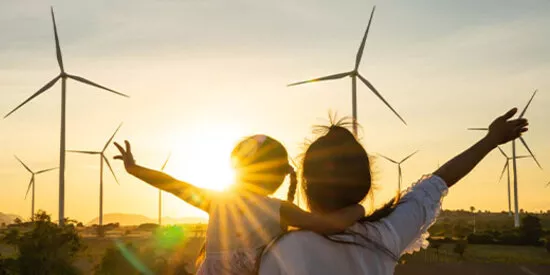
From quantity to quality: What is shifting China's economic growth?
The masks are off and growth is back on! After three lean years, China’s borders are open, travel is possible again and the economy is starting to rebound, the labour market and real estate prices are starting to recover.
With life getting back to normal, it is worth asking when and where Chinese consumers will spend their accumulated savings and how this will change the world’s second-largest economy?
Their capacity for some serious ‘revenge’ spending is not in doubt. Household deposits in China surged by more than a tenth of GDP over the past three years and now stand at over 100% of gross national income. Even if they spend just one 1% of GDP this year, it would be enough to support a rebound in real household consumption growth to 7% from a negative 0.2% in 20221 , notes He Xin, Head of Global Markets for China at Societe Generale. “But I am very optimistic and believe the recovery in consumer confidence will be better than expected”, he adds.
That Chinese consumers are eager to spend is equally apparent but, at least initially, the bulk of that spending is occurring at home. In February alone, 226m people travelled domestically, a 71% increase on the prior year. Internal tourism revenues jumped 30%. Cinema takings during the Spring Festival were the second highest in history2 . Shoppers also flocked to buy premium home appliances during that holiday: data from e-commerce platform JD and online retailer Suning showed sales of robot vacuums, blenders, dishwashers and giant TVs were all up between 120% to 500%3.
The recovery in the labour market conditions is also important for a sustained recovery. Consumer services, which account for a quarter of total employment, have been severely affected by the pandemic, points out Michelle Lam, Greater China Economist at Societe Generale: “A normalisation in that segment should support job creation and household income as consumption drives the economy.” Even with net exports slowing down, the bank is forecasting above-consensus GDP growth of 5.8% for 20234.
A different kind of recovery
For Beijing, this spending surge is doubly welcome. Not only does it boost recovery per se; it helps shift the economy away from its historic reliance on infrastructure investment that has too often been inefficient and just increased public sector debt. While infrastructure spending will remain significant, Mr He notes that the focus is shifting from traditional assets like roads, buildings and airports to more ‘consumption-oriented’ facilities such as warehouses and data centres, 5G towers, hospitals and laboratories. There will also be a lot of spending to boost the energy transition.
This is being coupled with a more pragmatic and balanced policy stance towards the private sector generally and the technology sector in particular – affirmed by the recent ‘Two Sessions5’, China’s yearly plenary meetings of the National People’s Congress (NPC) and the Chinese People’s Political Consultative Conference (CPPCC) to discuss and approve national priorities. Separately, the end of zero-Covid has also freed up resources. Put it all together and Beijing in 2023 is in a much stronger position: it should be able to support the economic recovery via focused spending and investment without having to deliver either broad fiscal or monetary easing.
Some of the pent-up demand from China’s consumers, meanwhile, will of course be spent abroad, travel, hospitality and luxury goods set to benefit most, but disproportionately in Asia. Societe Generale estimates that Chinese outbound tourism will recover to half of 2019 levels by the end of this year and places with a more welcoming stance towards mainland visitors, like Thailand.
In the longer term, as the disposable income of Chinese citizens increases and regional connectivity expands, China will continue to pull Asia along in its wake in terms of growth, as it has in the past – with the greater size of the economy compensating for its lower velocity.
China’s changing global role
China’s reopening will support near-term resilience in global growth this year. However, the spillovers to global demand of China’s recovery will be different this time. “The main driver of recovery is not investment but household consumption, which has a much lower import content”, argues Ms Lam. That means less of an impact on worldwide commodity prices and inflation.
Still, it would be a mistake to see this as evidence of a more specific decoupling between China and the ‘West’. In fact, global trade has reached new highs over the past two years, even though China’s share of US imports has declined somewhat since the imposition of tariffs.
Much of the talk about multi-nationals leaving China is simplistic. Some are setting up a separate supply chain for the US in order to avoid restrictions. Others are switching to a ‘China+1’ strategy: retaining China as their main source of goods while building an additional supply chain in another country, like Vietnam. Many are doing both. For most international companies, China is simply too big to ignore.
In conclusion, China’s recovery will be different this time: growth will be slower than in the past, but also higher quality as spending shifts to consumption and new sectors. This will create fresh opportunities, says Mr He and the role of banks like Societe Generale is to help corporates and investors to seize these while managing their risk across business cycles and asset classes.


1-https://insight-public.sgmarkets.com/insights/China-reopening-boom
2-http://www.china.org.cn/arts/2023-01/29/content_85078304.htm
3-https://www.chinadaily.com.cn/a/202302/23/WS63f6bd79a31057c47ebb058f.html
4- https://insight-public.sgmarkets.com/insights/recession-must-wait
5-https://www.cgtn.com/two-sessions-2023.html

日本のエネルギー・トランジションに向けて「東」と「西」を結ぶ
昨年ソシエテ・ジェネラルがグローバルロードショーの一環として開催した「ポジティブ・インパクト・デー」の東京会場では、日本の脱炭素化政策と国際的なパートナーとしての役割について、最新の動向を踏まえた活発な議論がなされました。

2024年第4四半期および2024年通期決算
パリ、2025年2月6日




